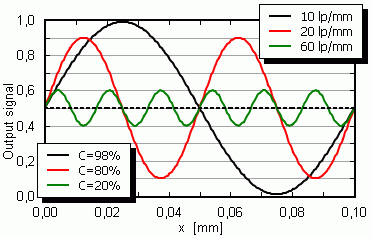Bright light conditions: the limiting resolution

In bright light level conditions the image is virtually free of "photon granularity". The optical resolution in line pairs /mm is constant and does not depend on the illumination intensity. These working conditions are called resolution limited regime and the limiting resolution is described by means of the Modulation Transfer Function (MTF) and the Contrast Transfer Function CTF.
The contrast C of an optical system is a function of the spatial modulation frequency of the input signal. The input must be 100 % modulated and may be an image of parallel
black and white line pairs. The output will then be an image of darker gray and lighter gray line pairs. The contrast of the output is then defined by
C = (max. brightness - min. brightness) / (max. brightness + min. brightness)
with the
brightness taken from the output image. This contrast depends on the spatial frequency: the more line pairs per millimeter, i.e. the smaller the images details, the lower the contrast of the output.

For example:
Input signal contrast:
Cin = (100 - 0) / (100 + 0) = 1,0 for all spatial frequencies.
The corresponding output signals contrasts may then be: 10 lp/mm: Cout = (99 - 1) / (99 + 1) = 98%
20 lp/mm: Cout = (90
- 10) / (90 + 10) = 80%
60 lp/mm: Cout = (60 - 40) / (60 + 40) = 20%
as shown in the diagram.
The difference between the modulation transfer function and the contrast transfer function is only that for the measurement of the MTF a sinusoidal input signal is applied, whereas a square wave function is used for the CTF measurement.
The human eye is able to notice a contrast down to 3 %, which therefore is defined as Limiting Resolution RL. In the following we give the limiting resolutions of the single ICCD components and the resulting limiting resolution of the whole ICCD camera.
1. Photocathode
The limiting resolution of the photocathode depends mainly on the acceleration voltage between photocathode and micro channel plate. It amounts to about 140 lp/mm.
2. Micro Channel Plate
With a mean distance between two micro channels of 6 microns the limiting resolution of a single stage microchannel plate results in 85lp/mm.
3. Phosphor Screen
The limiting resolution of the phosphor screen is given by the voltage between micro channel plate and phosphor screen and by the thickness of the phosphor layer. It typically amounts to 120lp/mm.
4. Coupling Lens
The Stanford Computer Optics coupling lenses achieve a limiting resolution of more than 260lp/mm.
Manufacturer of image intensifiers often state a limiting resolution of up to 62lp/mm or even more for intensifiers with a 18mm aperture. However, our experience from working 20 years in the field of ICCD cameras suggest a more realistic and reliable
value of about 44. Of course, this does not sound as good, but it's simply reality today. But, combined with the reproduction factor of our coupling lenses of 2.25 this gives a limiting resolution of the image at the CCD chip's surface of 100lp/mm.
For comparison, a standard resolution 1/2" CCD chip with 780 x 580 pixels has a maximum resolution of 58lp/mm and a high resolution 1/2" CCD chip with 1360 x 1020 pixels provides 106lp/mm.
